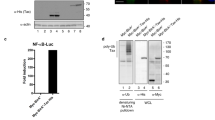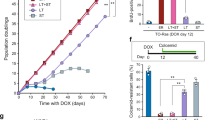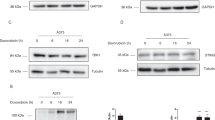Abstract
Simian Virus 40 Large T-antigen expressed in NIH3T3 cells increases p53 level and interacts with this tumor suppressor to form large nuclear complexes. We show here that T-antigen sensitizes NIH3T3 cells to low doses of the oxidative stress inducer menadione. This oxidant increased p53 accumulation and disrupted p53/T-antigen interaction, but not T-antigen/pRb, T-antigen/Hsc70 and p53/Hsc70 complexes; a phenomenon inhibited by the anti-oxidant N-acetyl-cysteine. Analysis of several p53 downstream gene products revealed that the level of Fas receptor, which was sharply reduced by T-antigen expression, was drastically increased in response to menadione treatment. Menadione also induced a T-antigen dependent cleavage of Fas ligand. Analysis performed with Fas receptor antagonist antibody and metalloproteinases inhibitor revealed that menadione triggers a Fas-dependent death of a fraction of T-antigen expressing cells. This Fas pathway does not activate caspase 8 or 3, probably because of the inhibition induced by T-antigen, and leads to a necrotic cell death which contributes at least in part to the hypersensitivity of T-antigen transformed cells to oxidative stress.
This is a preview of subscription content, access via your institution
Access options
Subscribe to this journal
Receive 50 print issues and online access
$259.00 per year
only $5.18 per issue
Buy this article
- Purchase on Springer Link
- Instant access to full article PDF
Prices may be subject to local taxes which are calculated during checkout










Similar content being viewed by others
Abbreviations
- ROS:
-
reactive oxygen species
- NAC:
-
N-acetyl-cysteine
References
Abello PA, Fidler SA, Bulkley GB and Buchman TG. . 1994 Arch. Surg. 129: 134–140.
Aebi H. . 1984 Methods Enzymol. 105: 121–126.
Arrigo AP. . 1990 Mol. Cell. Biol. 10: 1276–1280.
Bauer MKA, Vogt M, Los M, Siegel J, Wesselborg S and Schulze-Osthoff K. . 1998 J. Biol. Chem. 273: 8048–8055.
Bennett M, Macdonald K, Chan Shiu-Wan I, Paul Luzio J, Simari R and Weissberg P. . 1998 Science 282: 290–293.
Bessho R, Matsubara K, Kubota M, Kuwakado K, Hirota H, Wakazono Y, Lin YW, Okuda A, Kawai M, Nishimomori R and Heike T. . 1994 Biochem. Pharmacol. 48: 1883–1889.
Bravard A, Hoffschir F, Ricoul M, Cassingena R, Estrade S, Luccioni C and Dutrillaux B. . 1993 Carcinogenesis 14: 21–24.
Butler LM, Hewett PJ, Butler WJ and Cowled PA. . 1998 Br. J. Cancer 77: 1454–1459.
Cadenas E. . 1989 Ann. Rev. Biochem. 58: 79–110.
Carter WO, Narayana PK and Robinson JP. . 1994 J. Leukocyte Biol. 55: 253–258.
Clement MV and Stamenkovic I. . 1996 EMBO J. 16: 215–225.
DeCaprio JA, Ludlow JW, Figge J, Shew JY, Huang CM, Lee WH, Marsilio E, Paucha E and Livingston DM. . 1988 Cell 54: 275–283.
Deppert W and Haug M. . 1986 Mol. Cell Biol. 6: 2233–2240.
Dornreiter I, Erdile LF, Gilbert IU, von Winkler D, Kelly TJ and Fanning E. . 1992 EMBO J. 11: 769–776.
Eckner R, Ludlow WJ, Lill NL, Olread E, Arany Z, Modjtahedi N, DeCaprio JA, Livingston DM and Morgan JA. . 1996 Mol. Cell Biol. 16: 3454–3464.
Eguchi Y, Shimizu S and Tsujimoto Y. . 1997 Cancer Res. 57: 1835–1840.
El-Deiry WS, Tokino T, Velculescu VE, Levy DB, Parsons R, Trend JM, Lin D, Mercer WE, Kinzler KW and Vogelstein B. . 1993 Cell 75: 817–825.
Enari M, Talanian RV, Wong WW and Nagata S. . 1996 Nature 380: 723–726.
Fabre-Jonca N, Gonin S, Diaz-Latoud C, Rouault JP and Arrigo AP. . 1995 Eur. J. Biochem. 232: 118–128.
Fanning E and Knippers R. . 1992 Ann. Rev. Biochem. 61: 55–85.
Fenton RG, Hixon JA, Wright PW, Brooks AD and Sayer TJ. . 1998 Cancer Res. 58: 3391–3400.
Friesen C, Herr I, Krammer PH and Debatin KM. . 1996 Nat. Med. 2: 574–580.
Gonin S, Fabre-Jonca N, Diaz-Latoud C, Rouault JP and Arrigo AP. . 1997 Cell Stress Chaper. 2: 238–251.
Green DR. . 1998 Nature 396: 629–630.
Hahne M, Rimoldi D, Schroter M, Romero P, Schreier M, French LE, Schneider P, Bornand T, Fontana A, Lienard D, Cerottini J and Tschopp J. . 1996 Science 274: 1343–1366.
Hainaut P, Rolley N, Davies M and Milner J. . 1995 Oncogene 10: 27–32.
Hueber AO, Zörnig M, Lyon D, Suda T, Nagata S and Evan GI. . 1997 Science 278: 1305–1309.
Juo P, Kuo CJ, Yuan J and Blenis J. . 1998 Curr. Biol. 8: 1001–1008.
Kamada S, Washida M, Hasegawa J, Kusano H, Funahashi Y and Tsujimoto Y. . 1997 Oncogene 15: 285–290.
Kayagaki N, Kawasaki A, Ebata T, Ohmoto H, Ikeda S, Inoue S, Yoshino K, Okumura K and Yagita H. . 1995 J. Exp. Med. 182: 1777–1783.
Kelley WL and Georgopoulos C. . 1997 Proc. Natl. Acad. Sci. 94: 3679–3684.
Khandjian EW. . 1995 Oncogene 10: 359–367.
Klausing K and Knippers R. . 1994 Cur. Top. Microbiol. Immunol. 144: 31–35.
Koike M, Ishino K, Kohno Y, Tachikawa T, Kartasova T, Kuroki T and Huh N. . 1996 Cancer Lett. 108: 185–193.
Kretz-Remy C, Mehlen P, Mirault ME and Arrigo AP. . 1996 J. Cell. Biol. 133: 1083–1093.
Kristjuhan A, Jaks V, Rimm I, Tooming T and Maimets T. . 1998 Oncogene 16: 2413–2418.
Lemaire C, Andreau K, Souvannavong V and Adam A. . 1998 FEBS Lett. 425: 266–270.
Mannervik B. . 1985 Methods Enzymol. 113: 490–495.
Manfredi JJ and Prives C. . 1994 Bioch. Biophys. Acta 1198: 65–83.
Mariani SM, Matiba B, Baumler C and Krammer PH. . 1995 Eur. J. Immunol. 25: 2303–2307.
McCarthy NJ, Whyte MK, Gilbert CS and Evan GI. . 1997 J. Cell. Biol. 136: 215–227.
Miyashita T and Reed JC. . 1995 Cell 80: 293–299.
Moorwood K, Price TNC and Mayne LV. . 1996 Exp. Cell Res. 223: 308–313.
Müller M, Strand H, Hugh EM, Heinemann H, Wadezak WJ, Hoffman W, Stremmel PH, Krammer PH and Galle PR. . 1997 J. Clin. Invest. 99: 403–413.
Müller M, Wilder S, Bannasch D, Israeli D, Lehlbach K, Li-Weber M, Friedman SL, Galle PR, Stremmel W, Oren W and Krammer PH. . 1998 J. Exp. Med. 188: 2033–2045.
Nagata S and Golstein P. . 1995 Science 267: 1449–1456.
Owen-Schaub LB, Zhang W, Cusack JC, Angelo LS, Santee SM, Fujiwara T, Roth JA, Deiseroth AB, Zhang WW, Kruzel E and Radinsky ER. . 1995 Mol. Cell Biol. 15: 3032–3040.
Paley EL. . 1996 Carcinogenesis 17: 939–945.
Parat MO, Richard MJ, Beani JC and Favier A. . 1998 Biol. Trace El. Res. 60: 187–203.
Perez D and White E. . 1998 J. Cell. Biol. 141: 1255–1266.
Pitti RM, Marsters SA, Lawrence DA, Roy M, Kischkel FC, Dowd P, Huang A, Donahue CJ, Sherwood SW, Baldwin DT, Godowski PJ, Wood WI, Gurney AL, Hillan KJ, Cohen RL, Goddard AD, Botstein D and Ashkenazi A. . 1998 Nature 396: 699–703.
Rothe G and Valet J. . 1990 J. Leukocyte Biol. 47: 440–446.
Rouquet N, Allemand I, Molina T, Bennoun M, Briand P and Joulin V. . 1995 Oncogene 11: 1061–1067.
Scaffidi C, Schmitz I, Krammer PH and Peter ME. . 1999 J. Biol. Chem. 274: 1541–1548.
Schmieg FI and Simmons DT. . 1988 Virology 164: 132–140.
Schreck R, Albermann K and Baeuerle PA. . 1992 Free Radic. Res. Commun. 17: 221–237.
Sompayrac L. . 1997 Virology 233: 130–135.
Stroh C and Schulze-Osthoff K. . 1998 Cell Death and Differ. 5: 997–1000.
Thompson DL, Kalderon D, Smith AE and Tevethia MJ. . 1990 Virology 178: 15–34.
Trauth BC, Klaas C, Peter AMJ, Matzku S, Moller P, Falk W, Debatin KM and Krammer PH. . 1989 Science 245: 301–305.
Vercammen D, Brouckaert G, Denecker G, Van de Craen M, Declercq W, Fiers W and Vandenabeele P. . 1998 J. Exp. Med. 188: 919–930.
Verhaegh GW, Parat MO, Richard MJ and Hainaut P. . 1998 Mol. Carcin. 21: 205–214.
Vermes I, Haanen C, Steffens-Nakken H and Reutelingsperger C. . 1995 J. Immunol. Methods 184: 39–51.
Von Reyer U, Strater J, Kittstein W, Gschwendt M, Krammer PH and Moller P. . 1998 Cancer Res. 58: 526–534.
Wu GS, Burns TF, McDonald ER 3rd, Jiang W, Meng R, Krantz ID, Kao G, Gan DD, Zhou JY, Musschel R, Hamilton SR, Spinner NB, Markowtiz S, Wu G and El-Deiry WS. . 1997 Nat. Genet. 17: 141–143.
Zhu JY, Abate M, Rice PW and Cole CN. . 1991 J. Virol. 65: 6872–6880.
Acknowledgements
We wish to thank Dominique Guillet for excellent technical assistance. S Gonin was supported by a doctoral fellowship from the Ministère de l'Enseignement Supérieur et de la Recherche and the Association pour la Recherche sur le Cancer. This work was supported by the following grants: 5204 from the Association pour la Recherche sur le Cancer and the Région Rhône-Alpes (to A-P Arrigo).
Author information
Authors and Affiliations
Rights and permissions
About this article
Cite this article
Gonin, S., Diaz-Latoud, C., Richard, MJ. et al. p53/T-antigen complex disruption in T-antigen transformed NIH3T3 fibroblasts exposed to oxidative stress: correlation with the appearance of a Fas/APO-1/CD95 dependent, caspase independent, necrotic pathway. Oncogene 18, 8011–8023 (1999). https://doi.org/10.1038/sj.onc.1203319
Received:
Revised:
Accepted:
Published:
Issue Date:
DOI: https://doi.org/10.1038/sj.onc.1203319



